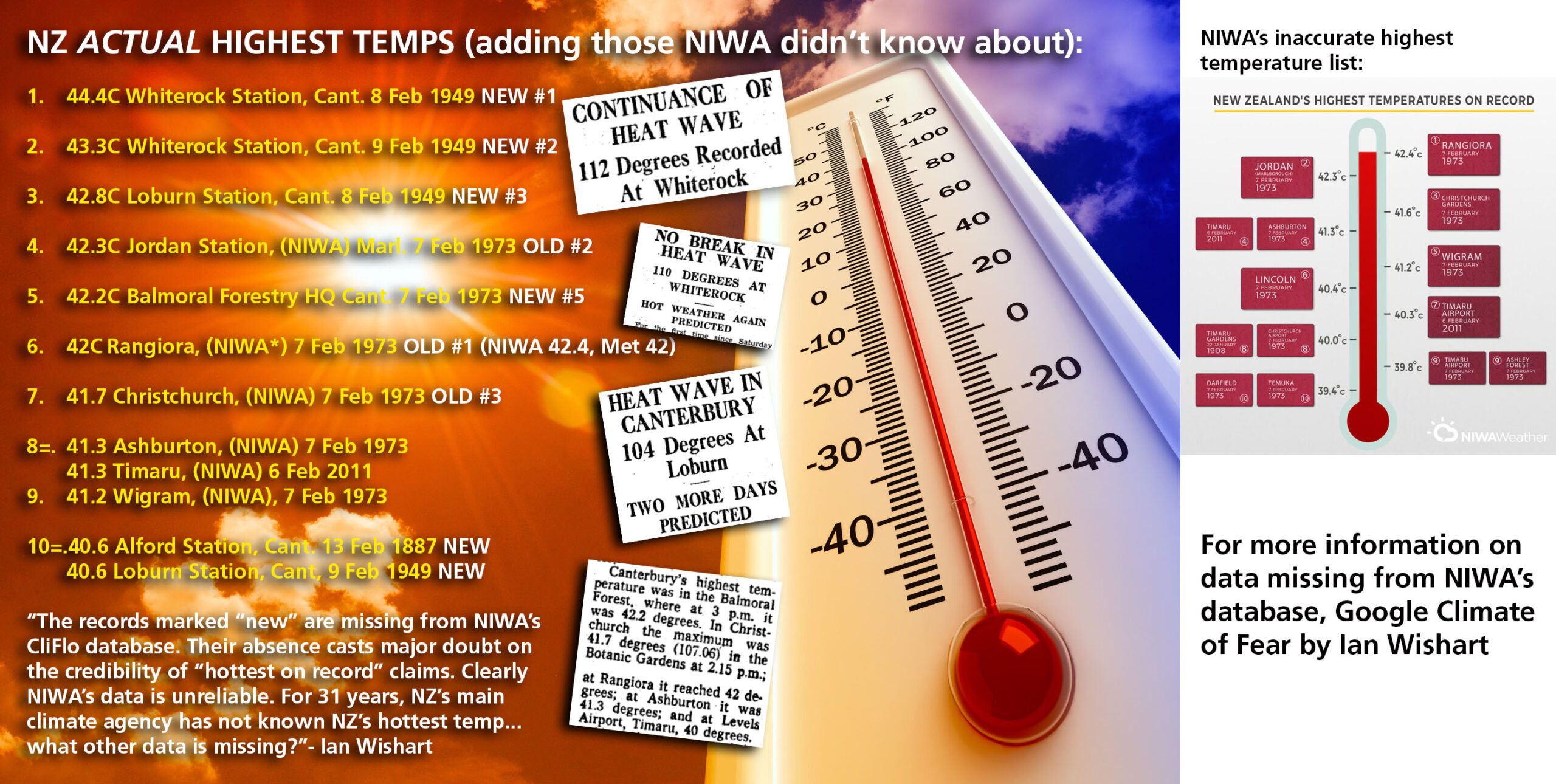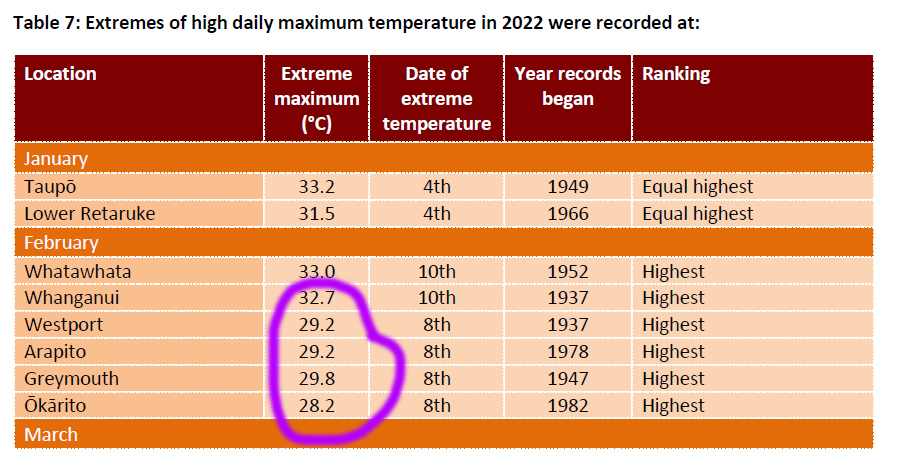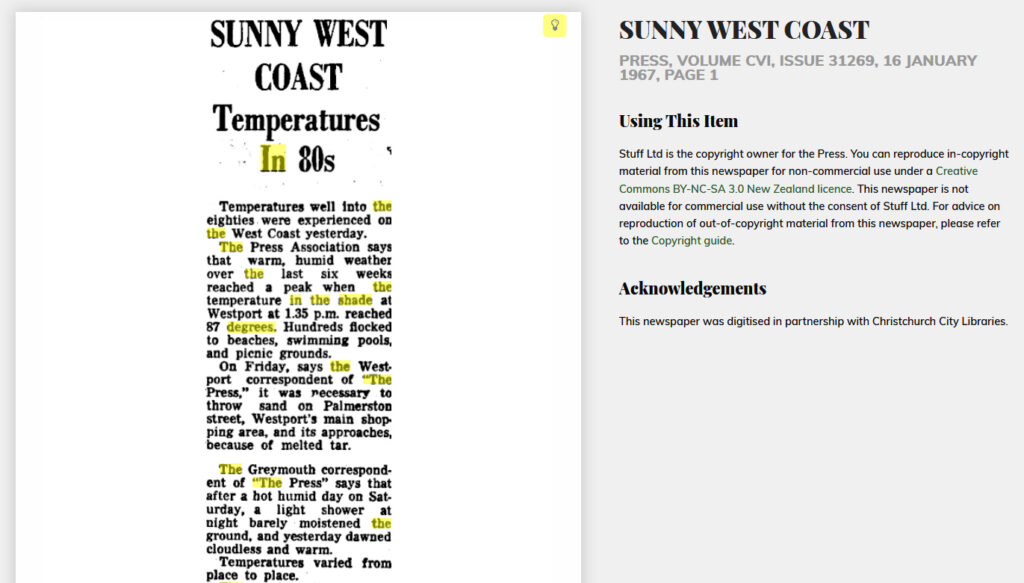
NIWA TEMPERATURE RECORDS FALSE: SPOT AUDIT
20 March 2023
[This article may be reproduced with acknowledgement to the author and Investigate Magazine]
Massive errors have been found in the official temperature records that government climate change agency NIWA has used to declare 2022 the “hottest year on record”.
The errors emerged during a spot audit of NIWA’s 2022 Annual Climate Summary report and, as investigative journalist IAN WISHART explains, the data errors are so serious that none of NIWA’s claims about highest temperature records over the past decade can be trusted:
NIWA’s Annual Climate Summary Report for 2022 has been found to contain false claims about record-breaking temperatures, nullifying its official statements that 2022 was “New Zealand’s hottest year on record”.
The mistakes are not simple typos during data entry: instead, they are a direct result of NIWA once again failing to enter historical data into its main CliFlo database.
Because the errors are based on a critical methodology failure, it means none of NIWA’s claims about other recent “hottest years” can be trusted by the government, the public or the news media, without a full audit of the main NIWA database against historical temperature data the agency has failed to enter in its system.
The 2022 Annual Climate Summary report contains tables, helpfully coloured in burnt ochre tones to symbolise fiery heat, just in case readers missed the point.

Table 7 of the Summary lists a series of locations that experienced record-breaking heat “extremes” during 2022. Included near the top of the list are Greymouth, Westport and other West Coast towns that suffered “extremes” of up to 29.8C (85.64 degrees Fahrenheit, for comparison to the historic records).
Greymouth, for example, hit 29.8C for the first time since records began in 1947.
There’s a long list of extremes, and NIWA uses the same core data to measure annual temperature averages and declare overall “hottest year on record”.
But let’s take a look at Greymouth and the West Coast heatwave of 8 February 2022. We can only take NIWA at their word that Greymouth has never hit 29.8C (85.64F) since NIWA records began in 1947.
Just like with the missing “extreme weather events” scandal, the historical PapersPast database blows NIWA’s CliFlo records into the weeds. A search of the West Coast newspapers for the exact phrase “86 degrees” revealed numerous occasions where the West Coast has topped 86F (30C):
This report from 9 February 1906.
This report from 17 December 1910.
This report also from 17 December 1910.
This report from March 1928.
The search was expanded to 87 degrees (30.6C).
This report from 3 February 1866.
An incredible 89 degrees Fahrenheit (31.7C) emerged on 14 February 1918
Greymouth hit 90F, this report from 24 January 1889.
An extreme of 90F struck again just a couple of years later.
Greymouth has even reached 92F (33.3C).
Westport’s newspaper noted a day so hot that people were frothing at the mouth. No temperature was recorded but nearby Reefton reported an incredible 96F (35.6C) in the shade on the same day in February 1927, a record beaten in December 1934 when Reefton reported 97F (36.1C) in the shade. It wasn’t Reefton’s first rodeo above 90F, there was a three day stint in February 1876.
CONCLUSION
The search through West Coast news archives was not exhaustive; but it didn’t need to be. NIWA “frothed at the mouth” in excitement when the coast recorded a single “extreme” of 29.8C (85.64F) for the first time ever in NIWA’s data – which only goes back to 1937/1947 for Westport/Greymouth respectively. It was, trumpeted NIWA, the “highest” ever recorded.
Only, as we now see, it wasn’t. Not even close. And if NIWA published what the media calls “misinformation” on West Coast climate records because their data is not fit for purpose, how many other weather records from other localities are also false? Without a line by line audit of hundreds of localities in the Annual Climate Summary there’s no way of knowing how deep the errors run.
At the very least, the Commerce Commission should step in and ban NIWA from ever using the misleading phrases “on record” or “since records began” because their data is too unreliable.
At best, NIWA should be forced to say “highest in 30 years” or however far back the data stretches, because that at least gives a range implication without implying it’s the highest “on record”.
NIWA has repeatedly claimed to have recorded New Zealand’s hottest year on several occasions since 2010. Now that holes in their temperature database have been found, big enough to fly a jumbo jet through, none of NIWA’s temperature claims can be trusted. We can’t even audit their existing temperature data as NIWA don’t release it.
And all of this – all of it – once again comes back to NIWA’s failure in 31 years of existence as a climate research agency to actually load our historical climate data into their main database.
Is it because they knew past climate was more extreme and, it turns out, hotter than they’d like us to think? Lots of nagging questions remain.
UPDATE: Turns out NIWA’s data embarrassment is even worse. Table 7, pictured earlier, says Westport has never reached 29.2C (84.6F) since records began in 1937. If that’s true, what on earth is this 1967 news report?

